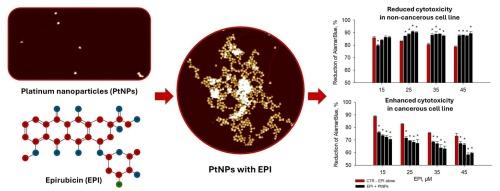铂纳米粒子与表阿霉素的相互作用与表阿霉素的生物活性呈大小依赖性。
IF 4.3
2区 医学
Q1 PHARMACOLOGY & PHARMACY
European Journal of Pharmaceutics and Biopharmaceutics
Pub Date : 2025-09-10
DOI:10.1016/j.ejpb.2025.114866
引用次数: 0
摘要
2022年,全球新增癌症病例近2000万例。尽管癌症治疗取得了不可否认的进步,但由于严重的副作用,常用的化疗方法仍然受到限制。因此,在本研究中,我们利用不同大小的铂纳米颗粒(PtNPs)来研究它们与常用抗癌药物表柔比星(EPI)的相互作用,并评估它们对其生物活性的影响。我们采用多种物理化学方法,包括荧光和红外光谱、差示扫描量热法、等温滴定量热法、原子力显微镜和动态光散射Zeta电位测量,研究了PtNPs与EPI的相互作用和聚集模式。此外,这些相互作用的生物学效应,特别强调纳米颗粒大小的差异,在肠沙门氏菌血清型鼠伤寒杆菌TA98的Ames诱变试验和MelJuSo(癌)和HaCaT(非癌)细胞系的细胞毒性试验中得到证实。得到的结果证实了PtNPs-EPI相互作用的存在,这取决于纳米颗粒的大小。理化分析揭示了epi诱导的纳米粒子聚集体的形成,这可能在生物效应的背景下具有重要意义。因此,生物学部分表明,PtNPs降低了EPI在癌细胞中的诱变性,增加了其细胞毒性。相反,纳米颗粒对细胞有潜在的保护作用,主要是增加或维持非癌细胞系的细胞活力。综上所述,我们的研究为PtNPs对表柔比星的影响提供了有价值的见解,并特别关注了纳米颗粒大小的差异。本文章由计算机程序翻译,如有差异,请以英文原文为准。

Platinum nanoparticles interact with epirubicin in size dependent manner and affect its biological activity
In 2022, nearly 20 million new cancer cases were diagnosed worldwide. Despite undeniable improvement in cancer treatment, chemotherapy, a frequently used method, remains limited due to severe side effects. Hence, in this research we utilized platinum nanoparticles (PtNPs) of varying sizes to investigate their interactions with epirubicin (EPI), a commonly used anticancer drug, and asses their impact on its biological activity.
We employed various physicochemical methods, including Fluorescence and Infrared Spectroscopies, Differential Scanning Calorimetry, Isothermal Titration Calorimetry, Atomic Force Microscopy and Dynamic Light Scattering with Zeta Potential measurements, to investigate the interactions and aggregation patterns of PtNPs with EPI. Moreover, the biological effect of these interactions, with a particular emphasis on the differences due to nanoparticles’ sizes, was verified in Ames mutagenicity test on Salmonella enterica serovar Typhimurium TA98 and through cytotoxicity assays on MelJuSo (cancerous) and HaCaT (non-cancerous) cell lines.
The obtained results confirmed the presence of PtNPs-EPI interactions depending on the nanoparticles’ size. The physicochemical analyses revealed the formation of EPI-induced aggregates of nanoparticles, which may be of great importance in the context of the biological effects. Consequently, the biological part indicated that PtNPs decrease EPI mutagenicity and increase its cytotoxicity in cancerous cell line. In the contrary, nanoparticles exhibited a potential protective effect on cells and mostly increased or maintained the cells viability in non-cancerous cell line. Summing up, our research provides valuable insights into the PtNPs influence on epirubicin with special focus on the differences attributed to nanoparticles sizes.
求助全文
通过发布文献求助,成功后即可免费获取论文全文。
去求助
来源期刊
CiteScore
8.80
自引率
4.10%
发文量
211
审稿时长
36 days
期刊介绍:
The European Journal of Pharmaceutics and Biopharmaceutics provides a medium for the publication of novel, innovative and hypothesis-driven research from the areas of Pharmaceutics and Biopharmaceutics.
Topics covered include for example:
Design and development of drug delivery systems for pharmaceuticals and biopharmaceuticals (small molecules, proteins, nucleic acids)
Aspects of manufacturing process design
Biomedical aspects of drug product design
Strategies and formulations for controlled drug transport across biological barriers
Physicochemical aspects of drug product development
Novel excipients for drug product design
Drug delivery and controlled release systems for systemic and local applications
Nanomaterials for therapeutic and diagnostic purposes
Advanced therapy medicinal products
Medical devices supporting a distinct pharmacological effect.

 求助内容:
求助内容: 应助结果提醒方式:
应助结果提醒方式:


